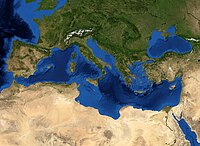
Photo from wikipedia
Historically, the olive grove has been one of the most emblematic ecosystems in Mediterranean countries. Currently, in Andalusia, Spain, the land under olive grove cultivation exceeds 1.5 million hectares, approximately… Click to show full abstract
Historically, the olive grove has been one of the most emblematic ecosystems in Mediterranean countries. Currently, in Andalusia, Spain, the land under olive grove cultivation exceeds 1.5 million hectares, approximately 17% of the regional surface. Its exploitation has traditionally been based on the use of the available land and heterogeneous plantations, with different species adapted to southern Mediterranean climatic conditions, and to the management of the traditional olive cultivation culture. The objective of this work is to characterize the mechanical behavior of the atmospheric surface boundary layer (SBL) (under neutral stability) interacting with different olive grove configurations. Experimental tests were carried out in the Boundary Layer Wind Tunnel (BLWT) of the Andalusian Institute for Earth System Research (IISTA), University of Granada. Three representative configurations of olive groves under neutral atmospheric conditions were tested. The wind flow time series were recorded at several distances and heights downwind the olive plantation models with a cross hot wire anemometry system. Herein, this paper shows the airflow streamwise, including the mean flow and the turbulent characteristics. The spatial variability of these two mechanical magnitudes depends on, among others, the size, the agro-forest length, the layout of the tree rows, the porosity, the tree height, the crown shape and the surface vegetation cover. The aerodynamic diameter and Reynolds number for each agro-forest management unit are proposed as representative variables of the system response, as these could be related to olive grove management. The plantation, in turn, conforms to a windbreak, which affects the microclimate and benefits the elements of the ecosystem. Detailed knowledge of these variables and the interaction between the ecosystem and the atmosphere is relevant to optimize the resources management, land use and sustainability of the overall crop. Thus, this paper presents preliminary work to relate atmospheric variables to environmental variables, some of which could be humidity, erosion, evapotranspiration or pollen dispersion.
Journal Title: Atmosphere
Year Published: 2021
Link to full text (if available)
Share on Social Media: Sign Up to like & get
recommendations!